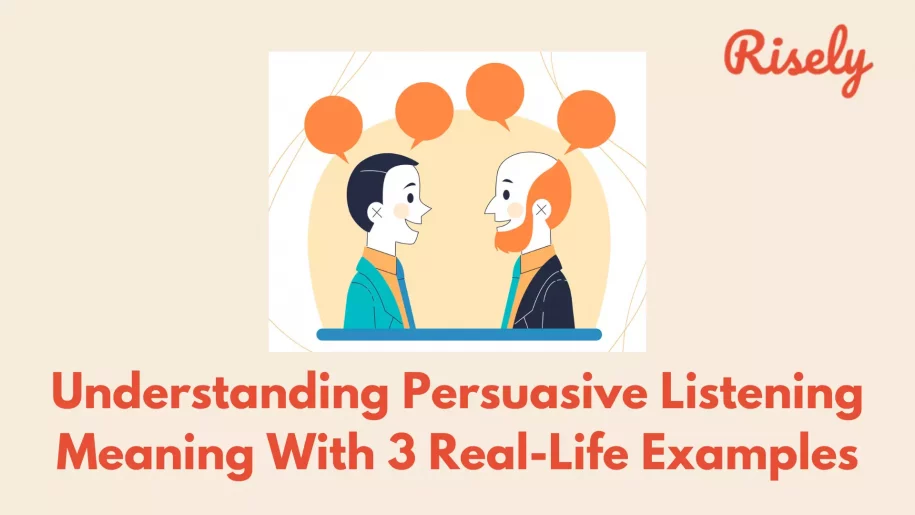Understanding Persuasive Listening With 3 Real-Life Examples
Have you ever been in a discussion where you felt like you were not being heard? Or you’ve been on the other end, trying to get your point across, but the other person seems more interested in pushing their agenda. It can be frustrating and unproductive. That’s where persuasive listening comes in. It’s an assertive communication technique that can help you build stronger relationships, make better decisions, and achieve your goals. In this blog, we’ll explore the concept of persuasive listening and provide practical tips for incorporating it into your daily conversations. In addition, we’ll examine the critical skills required for persuasive listening and how to develop them. Whether in sales, management or just looking to improve your communication skills, persuasive listening can help you become a better listener and communicator. So, let’s plunge in and learn how to harness the power of persuasive listening.Understanding the Persuasive Listening Meaning
Persuasive listening refers to actively listening to someone to understand their perspective and then using that understanding to guide the conversation toward a desired outcome or decision. It involves paying close attention to the speaker’s words, tone, and body language to gain a thorough understanding of their message and then using that understanding to effectively communicate and persuade them to take a particular action or adopt a specific viewpoint. This type of listening requires empathy, patience, and an open-minded approach to understanding the other person’s perspective.Other Interesting Reads
Persuasive Listening Skills to Become a Better Listener
As of now, you have understood persuasive listening meaning now you need to understand the communication skill you need to focus on for understanding and responding to the speaker in a way that helps build rapport, trust, and mutual understanding. In addition, these skills are used to persuade or influence others by actively listening to their ideas, opinions, and concerns. Skills such as;- Active listening: Paying close attention to the speaker’s words, tone of voice, point of view, and nonverbal cues to fully understand their message.
- Empathy: Showing genuine concern and understanding for the speaker’s perspective, feelings, and needs.
- Asking clarifying questions: To ensure you clearly understand the speaker’s message.
- Reflecting and paraphrasing: Restate the speaker’s message in your own words to show that you understand their perspective and to confirm your understanding.
- Acknowledging emotions: Recognizing and validating the speaker’s emotions, even if you don’t necessarily agree with their point of view.
- Building on the speaker’s ideas: Responding to the speaker in a way that shows that you have heard their ideas and are willing to build on them to find common ground.
Persuasive Listening Techniques to Work on to Become a Better Listener
Persuasive listening is the art of listening with the intent to understand and influence others. It involves paying attention to verbal and nonverbal communication, asking open-ended questions, and showing empathy and understanding. To practice persuasive listening skills and become an effective communicator, you can follow persuasive listening techniques such as:- Active Listening: Active listening involves giving full attention to the speaker, acknowledging what they are saying, and asking clarifying queries to ensure you understand their message. This technique demonstrates your interest in the speaker and shows that you value their opinion.
- Empathetic Listening: Empathetic listening involves understanding the speaker’s perspective from their point of view. This technique requires you to listen without judgment, show compassion and sensitivity to the speaker’s feelings, and respond in a way that shows you understand their emotions.
- Reflective Listening: Reflective listening involves restating what the speaker has said in your own words to ensure that you have received and understood their message correctly. This technique demonstrates that you are actively listening and paying attention to what the speaker is saying.
- Clarifying Questions: Asking open-ended questions can help clarify the speaker’s message and show that you are interested in what they have to say. This technique also encourages the speaker to provide more detailed information, which can help you better understand their perspective.
- Mirroring: Mirroring involves matching the speaker’s body language, tone of voice, and pace of speech to create a sense of rapport and connection. This technique can put the speaker at ease and make them more receptive to your message.

Persuasive Listening Real-life Examples: How it is Effective in Different Professions
Salespeople
Salespeople are experts at persuasive listening. They actively listen to their customers to understand their needs and wants and tailor their sales pitch to address those concerns. In addition, they use active listening skills to empathize with their customers, which helps them build rapport and establish trust.Therapists
Therapists use persuasive listening to help patients work through emotional or psychological issues. They listen carefully to their patient’s concerns and use their words and body language to convey empathy and understanding. By listening actively, therapists can build trust and help their patients feel heard and understood.Politicians
Politicians use persuasive listening to connect with voters and build support for their political agenda. They actively listen to their constituents to understand their concerns and then use their words to convince them that their policies are in their best interest. As a result, politicians can build trust and establish a loyal following by demonstrating that they know their constituents’ concerns.Conclusion
We have understood persuasive listening meaning, the skills required, and the techniques to flourish those skills to be an effective communicator. You can become an effective persuasive listener by practicing active listening, empathy, questioning, and acknowledging emotions. Persuasion is a valuable and in-demand skill; for more information about persuasion or other managerial skills such as leadership, decision-making, critical thinking, etc., you can sign up to Risely and develop a better understanding.How well are you following the examples of persuasive leaders?
Find out now with Risely’s free persuasion skill assessment for managers who do not hold back!
FAQs
What are the 4 types of listening?
The four types of listening are:
1. Active Listening
2. Empathetic Listening
3. Reflective Listening
4. Claryfing Listening
1. Active Listening
2. Empathetic Listening
3. Reflective Listening
4. Claryfing Listening
How to use persuasive listening in the workplace?
To use persuasive listening in the workplace, actively listen to colleagues’ concerns and goals, acknowledge their perspectives, and seek to understand their needs. Then, tailor responses to address those needs and negotiate solutions.
What are the advantages of persuasive listening?
Persuasive listening can improve communication, build trust, and increase understanding. It allows the listener to identify the speaker’s needs, concerns, and goals and tailor their response to persuade and negotiate effectively.
Other Related Blogs
Executive Communication Coach: When And How To Choose
Executive Communication Coach: When And How To Choose Good communication is a must for professional success. After all, half of people management is all about saying the right things in…
5 Unique Benefits Of Online Leadership Coaching
5 Unique Benefits Of Online Leadership Coaching Remember the days of leadership development being confined to a stuffy conference room filled with flipcharts and generic advice? Yeah, those days are…
Performance Management Training: Empowering Managers To Manage Better
Performance Management Training: Empowering Managers To Manage Better Remember that feeling of dread when you knew performance review season was rolling around? Yeah, us, too. For many employees, performance reviews…
Manager Development Goals And How To Reach Them: Opportunities And Areas To Focus On
Manager Development Goals And How To Reach Them: Opportunities And Areas To Focus On You’ve meticulously crafted a development program for your high-potential employees, but their managers just aren’t on…


